What is the Internet of Things?
The Internet of Things (IoT) is becoming a more popular topic as we keep improving technologically. But what is the IoT?
Basically, the concept of IoT is connecting any physical device to the internet, and therefore, to each other. This creates a giant network of physical objects which can communicate through the IoT.
How does IoT affect the concrete industry?
Over the last 20 years, the concrete industry has implemented new technologies such as wired sensors for monitoring the performance in concrete. These sensors can monitor everything from concrete temperature, concrete maturity, and relative humidity of concrete. However, now with the IoT these sensors can communicate this data to our cell phones and computers wirelessly through the cloud. While concrete is being placed at the construction site, the concrete producer, contractors, and engineers can monitor concrete performance and make decisions in real-time throughout the entire job.
The IoT has also changed the game for ready mixed concrete trucks and delivery. Companies have developed technology to track dispatched trucks to the delivery location and communicate real-time data on anything that changes to the concrete mix before delivery. The trucks are complete with a stainless steel probe and sensors, including a thermometer and accelerometer, to transmit data to the onboard computer. The computer can then calculate slump and concrete volume for concrete monitoring. These “smart” concrete trucks replace the need for the old fashion delivery ticket and alert to any issues relating to the concrete before placement.
Ultimately, the improvements to concrete sensors and ready-mixed trucks through the IoT use technology to create concrete that is stronger and lasts longer.
How will this affect the future of concrete?
As the IoT continues to grow and advance, the concrete industry will be able to make incredible leaps in concrete monitoring and performance. New sensors are constantly becoming available to monitor rebar corrosion rate, half-cell corrosion potential, the electrical resistivity of concrete, and more.
This series explores the possibilities for concrete and IoT and highlights examples of current projects utilizing the IoT.
Now begs the question, how will we adapt as we bring concrete into 2030 and beyond?
DOTs Pave the Way for Innovation
State Departments of Transportation (DOT) has been one of the driving forces behind more advanced methods of concrete strength prediction and has paved the way for Concrete IoT.
A drawback when using concrete for pavements is the time delay, associated with hydration and hardening, to opening the concrete pavement for traffic. Within the last decade, state DOTs have employed rapid setting concrete mixtures for the early opening of traffic. Fast-Track Pavement design incorporates concrete mixtures that have strong development within hours compared to 7-days, a plus for standard concrete mixtures for pavements.
Boots on Ground
Many moons ago, while I was still cutting my teeth in the concrete and construction industry, I had the privilege of being part of a new product roll-out for Lafarge North America (now LafargeHolcim). The product was called, Chronolia TM, and was designed to reduce the time needed to open a concrete pavement to traffic. The team that I worked with adapted the original technology that was brought over from France (early ripping and stripping of concrete formwork) to be used for the early opening of traffic.
Running Into Traffic
Concrete maturity found its footing in the Fast Track Programs. Where a concrete manufacturer used maturity to assure that the concrete mix that is sold to the DOT will attain the ‘Traffic Opening” strength at the required time.
When I first started out developing these Fast Track pavements, we used to cast 6 x 12 inch and 4 x 8-inch cylinders, See Figure 1, which was broken later in the off-site laboratory, and then pop the concrete surface with a pendulum hammer, see Figure below.
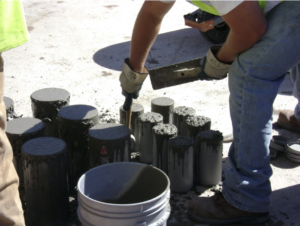 Figure 1 — Casting concrete cylinders on the job site to be tested at an off-site location.
Figure 1 — Casting concrete cylinders on the job site to be tested at an off-site location.
Casting and breaking concrete cylinders were rarely dependable with early strength breaks (less than 8 hours). If the concrete was cast at the plant, it might not have been representative of the concrete in the field, especially if water was added to the concrete on the job site. When concrete cylinders cast in the field were delivered to be tested there was always a concern about the negative impact that transporting the concrete cylinders had on strength development.
When it came to popping the concrete pavement surfaces with a pendulum hammer there were two issues. The primary concern was that the surface strength found from the pendulum hammer does not necessarily represent the strength development within the body of the concrete. We would first pop the hardened 6 x 12 cylinder and then pop the pavement, see Figure 2.
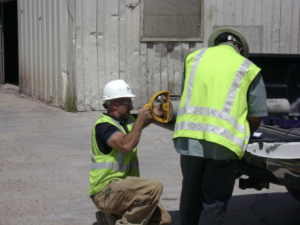 Figure 2 — The Pendulum Hammer in action. Testing concrete cylinders before we test the concrete structure.
Figure 2 — The Pendulum Hammer in action. Testing concrete cylinders before we test the concrete structure.
The secondary concern was running across lanes of traffic and crouching on the side of the interstate trying to determine the rebound value, see Figure 3.
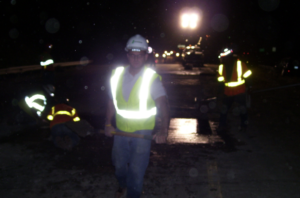 Figure 3 — Working the late-night shift on Interstate 25 in Colorado.
Figure 3 — Working the late-night shift on Interstate 25 in Colorado.
It wasn’t until about a year or 2 later that I was introduced to concrete maturity by a colleague. Where concrete maturity is recognized as:
“… a method to estimate strength development in construction based on the assumption that samples of a given concrete mixture attain equal strengths if they attain equal values of the maturity index regardless of temperature changes. Today, concrete maturity provides real-time data that enables the end-user to make better-informed and instantaneous decisions (Harris 2016).”
The maturity loggers are cast into the fresh concrete and once activated, record the change in temperature of the in-place concrete. Often times we sampled (concrete cylinders) on-site and in the laboratory with maturity loggers. At this point in the Fast Track Program (circa 2008) the maturity loggers and meters had to be wired to download the data set and determine the maturity value. And while this maturity method was cumbersome, it was a lot faster than breaking cylinders and a lot more accurate than pendulum hammers.
That being said, the wired systems for measuring concrete maturity on Fast Track Pavement job sites were far from instantaneous and posed safety risks. Just like the pendulum hammer, it was my job to run across lanes of traffic to connect to the logger and download data.
How does Concrete IoT Flip the Script?
The first time I was introduced to a wireless sensor for concrete maturity was around 7 years later at an American Concrete Institute Convention.
One of my buddies, Aali R. Alizadeh, had just started a concrete technologies company (Giatec) in Canada. Some of the concepts and technologies they were bringing to the industry were out of this world awesome. At the time Giatec was taking off with the R-Con device for determining bulk electrical resistivity in concrete. We wrote an awesome article on the subject → See Awesome Article, Innovative Testing Techniques for Concrete.
Aali and I had gone out for breakfast in a local diner outside the convention center. While sitting at the table eating my eggs and toast, Aali asked me,
“What if you could measure maturity without leaving your truck?”
I was intrigued and skeptical.
Aali continued,
“What if you didn’t need to buy a separate handheld device, all you needed was your phone?”
My bullshit meter was pinging at this point. There was no way that technology existed. That would revolutionize the industry.
While my mind raced with what this could do in the industry, safety on job sites, time and material saved; Aali placed a plastic cube on the table. From the plastic cube were three wires. Two looked like safety wires used to secure rebar around 5 inches long; the third wire looked like a temperature sensor that was around 12 inches long. The plastic cube was the SmartRock prototype, see Figure 4.
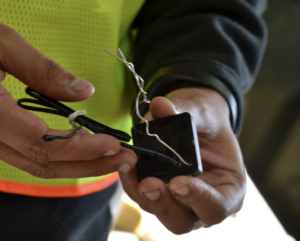 Figure 4 — Working with the SmartRock prototypes in our Colorado facility.
Figure 4 — Working with the SmartRock prototypes in our Colorado facility.
Aali proceeded to tie the two safety wires and drop the entire plastic cube in the glass of ice water I had been drinking. Then Aali opened a SmartRock App on his smartphone.
“HOLY *EXPLETIVE* *EXPLETIVE*!!! ARE YOU *EXPLETIVE* KIDDING ME??!!!” I yelled over my eggs and toast.
I watched as the temperature recording changed in real-time on his smartphone. When the SmartRock was in cold water the temperature dropped. When we pulled the SmartRock out of the ice-water and placed the sensor in my coffee the temperature climbed on Aali’s smartphone.
How are Wireless Maturity Systems Used?
Wireless sensors for maturity are extremely easy to install and use once the calibration mixes are run in the laboratory, Figure 5, in primary setup and calibration of the concrete mixture(Harris 2016).
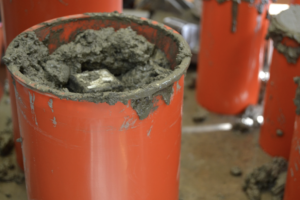 Figure 5 — SmartRock sensors cast into concrete for maturity measurements.
Figure 5 — SmartRock sensors cast into concrete for maturity measurements.
“The second step in implementing a maturity program is to attach a concrete maturity logger or meter in the formwork where the concrete in question is to be placed. The temperature history of the in-situ concrete, for which strength is to be estimated, is recorded from the time of concrete placement to the time when we want to estimate the strength. The recorded temperature history is used to calculate the maturity index of the field concrete (Harris 2016).”
The wireless sensor (like the SmartRock2) is tied to rebar with the concrete before the concrete is placed. The end-user can now connect to the embedded sensor wirelessly using their smart phone to obtain real-time information on concrete temperature, maturity, and strength. This gives the end-user the ability to make real-time decisions on the concrete job site; saving both time and money.
In our next part of this ‘IoT in Concrete Industry’ Series, concrete crack sensing is explored as a means for real-time analysis and disaster.
Written By: Jon Belkowitz, PhD, PE and Mallory A. Westbrook
